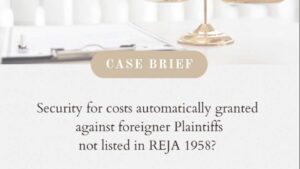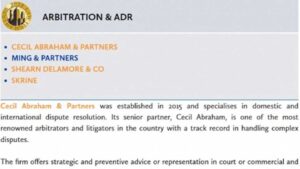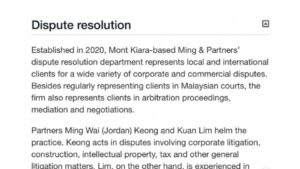
Introduction
A company or its owner (i.e. shareholders) may require funding for many reasons, for example, business start-up, expansion, acquiring properties or assets, research and development, etc. Finding suitable investors to inject capital into a company by way of share subscription is one of the most straight-forward methods of equity financing.
However, with more than one shareholder, disputes and conflicts amongst the shareholders may arise throughout the company’s business journey. The shareholders are therefore advised to enter into a shareholders’ agreement amongst themselves to regulate their business relationships, respective rights and obligations with the aim to avoid or minimise any potential dispute.
In this article, we will briefly discuss some clauses that may be included in the shareholders’ agreement to give advantage to the majority and/or minority shareholders.
Who Are Majority Shareholder and Minority Shareholder?
Majority shareholder is a shareholder who holds more than 50% ordinary shares in a company and therefore controls the board of directors and policies of the company.
Contrary to majority shareholder, a minority shareholder is a shareholder who holds less than 50% ordinary shares in a company. In view that the ordinary and special resolutions of a company shall respectively be passed by a simple majority1 and not less than 75%2 of votes, a minority shareholder is generally unable to pass any resolution on his own.

Advantages of Having A Shareholders’ Agreement
Shareholders can verbally agree upon many things. However, it would be very difficult to prove in court as to what the shareholders agreed upon unless the agreed terms are put into writing.
A shareholders’ agreement sets out clearly in writing the terms agreed upon by the shareholders and would be accepted in court as the primary evidence of what the shareholders have agreed on. The court would be able to inspect all the terms (eg: funding obligations, right to appoint directors, restriction on share transfer, procedure to resolve a deadlock, platform to resolve disputes, etc) set out in the shareholder’s agreement and deduce the intentions of the shareholders.
Further, there are many terms or clauses which can be inserted in the shareholders’ agreement to provide an edge to either the majority or the minority shareholder.
Clauses Advantageous to The Majority Shareholder
- Deadlock and exit clause
Shareholder’s dispute occurs all the time and sometimes it is so unpleasant and grim that it adversely affects the viability of the company’s business operation (“Deadlock”). The ultimate solution to an irreparable breakdown of business relationship or upon a Deadlock would be the exit of either shareholder. However, it is likely that neither of the shareholders is willing to compromise nor relinquish their stake in the company.
This situation can be avoided if the applicable procedures upon the occurrence of Deadlock have been negotiated and included in the shareholders’ agreement. There are many creative ways to structure the exit clause including compulsory buyout by one of the shareholders, Russian roulette method, fairest sealed bid method, mediation, etc.
Often, a majority shareholder is the founder of the business. We would recommend the majority shareholder to seek for investors who are willing to accept a compulsory buyout by the majority shareholder in the event of Deadlock. - Funding obligation
It is important to set out in a shareholders’ agreement the circumstances where a company can call for further fundings from both the majority and minority shareholders. By having the minority shareholder committed to such funding obligations, the majority shareholder is spared from repeating the long and exhausting process of identifying new investors whenever the company needs further funding.
The priority of funding mechanism (eg: third-party borrowing, shareholder’s loan, issuance of preference shares and/or ordinary shares, etc) may also be set out in the shareholders’ agreement for clarity. - Drag-along right
In the event where the majority shareholder intends to dispose off the company, there are times where a new buyer is only interested in acquiring all the shares (i.e. including all the shares held by the minority shareholders) in the company. In this instance, the share sale may fail if any of the minority shareholders refuses to dispose its shares to the new buyer.
Having a drag-along right (granted to the majority shareholder) in the shareholders’ agreement may avoid this situation. A drag-along right empowers the majority shareholder with the right to compel the minority shareholders to jointly dispose off all their shares to the new buyer, at the same negotiated price per share.
In order words, the majority shareholder would be able to drag-along the shares held by the minority shareholders in such share sale and hence the terminology “drag-along”. Having a drag-along clause would render the majority shareholder with more flexibility and leverage in negotiating with potential new buyer.

Clauses Advantageous to The Minority Shareholder
- Right to nominate director
Directors can be appointed and removed via an ordinary resolution. Generally, a minority shareholder who holds less than 50% shares in the company would not be able to appoint a representative to the board.
Nonetheless, minority shareholder may negotiate for the inclusion of the right to nominate directors in the shareholders’ agreement. With that, the majority shareholder would be contractually bound to take all steps and pass all resolutions in relation to the appointment and removal of such directors nominated by the minority shareholder. - Non-dilution right
As a minority shareholder, one of the main concerns when investing in a company is the risk of having its stake diluted as that may adversely affect the return of his investment. To avoid his stake from being diluted, a minority shareholder is encouraged to negotiate for the inclusion of a non-dilution clause in the shareholders’ agreement.
Alternatively, the minority shareholder may also request for matters in respect of share issuance be categorised as a “reserved matter” which requires unanimous votes from all shareholders. - Tag-along right
Contrary to drag-along right, tag-along right is a right granted to a minority shareholder which can be exercised when the majority shareholder disposes off his shares to a new buyer.
If the minority shareholder exercises the tag-along right, the majority shareholder is required to procure the new buyer to also acquire all the shares held by said minority shareholder at the same negotiated price per share. In other words, the minority shareholder gets to tag-along in the share sale, hence the terminology “tag-along”.
The board may decide to not declare dividend and retain the company’s profits for future expansion or any other purpose. In the event where the minority shareholder prefers to have short-term returns, a dividend policy to this effect should be spelled out in the shareholders’ agreement. With that, the majority shareholder (through his control over the directors) and the company would be contractually bound to comply with the said dividend policy. - Dividend policy
The decision whether to distribute dividends rests with the board of directors. A minority shareholder has little or no say in this matter as it does not have a majority representatives at the board level.
Conclusion
In view of the advantages and protection it offers to both the majority and minority shareholders, shareholders are advised to draw up a shareholders’ agreement and negotiate for the inclusion of clauses which are advantageous to them. A shareholders’ agreement can be simple or advanced, depending on the shareholders’ needs and level of sophistication.
Authored by
Loo Hao Han, a Partner of Ming & Partners. Hao Han assisted many clients to draft and negotiate for shareholders’ agreements. He often thinks outside the box and offers creative solutions or positions that do not compromise the interests of all shareholders.
References
- S. 291 of the Companies Act 2016
- S. 292 of the Companies Act 2016













